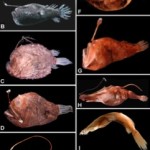When I was about 15 or 16, I went fishing with my step-brother. We weren’t really catching anything so we decided to drop a hook down to the bottom and try our luck. And then something bit. It was big. Almost much too big for the toothpick poles we were using. After much effort, we pulled up what I then decided was the ugliest fish I had ever seen onto the deck, a Monkfish.

Also known as the goosefish, a monkfish is a species of anglerfish. Expert lurker with a giant mouth and tiny lure. These fish are generally bottom dwellers that snap up any unsuspecting prey that get within reach of their ridiculously large gaping jaws. The one we snagged managed to swallow the hook and then bite my step-brother on the thumb when he tried to retrieve it. While apparently good eatin’, in the end we decided to throw the monster back into the deep.
But you know what else these hideous fish swallow besides my fish hook? This insanely precious seabird, the Dovekie (AKA Little Auk).

Bird remains had been previously found in Monkfish stomachs, but it was a little bit of a mystery as to why a surface floating bird would eaten by a bottom dwelling fish. The answer is the ocean equivalent of a Craigslist Missed Connection being connected. Recent tagging studies of monkfish have indicated that Monkfish sometimes swim vertically to the surface, especially during their spring and fall migrations. It is here, near the surface, where the territories of the monkfish and dovekies collide. Dovekies dive for food, often as deep as 100 ft, well into the range of the monkfish’s vertical migrations. And if you are a hungry monkfish swimming about, a chance meeting with a diving dovekie is a great way to score an easy snack. Watch a monkfish demonstrates its snacking prowess and you will understand why these teeny birds are so defenseless against these massive mandibles.
While I may paint the monkfish as some nefarious devourer of tiny sea birds, they are not alone in their avian appetites. Searching the NOAA NEFSC food-habits database, researchers also found that “spiny dogfish, Atlantic herring, pollock, Atlantic cod, red hake, and fourspot flounder” also eat birds have had birds or feathers found in their stomachs. But then again, it’s just not that common. So next time you have a fish on your plate for dinner, just remember you could be eating poultry too!
UPDATE: The paper that this post is based on, Predation on Dovekies by Goosefish over Deep Water in the Northwest Atlantic Ocean, was posted online after this article was written. Here are some more fascinating aspects of a typical monkfish diet:
- The dovekies that were removed from the stomachs of the monkfish were barely decomposed. This suggests that the birds were just recently eaten, so recent that there wasn’t even time for proper digestion.
- Monkfish also eat rocks, sand and other plastic pieces. If those were my other snacking options, I would probably eat dovekies too.
- Previous to this study, no one had ever reported monkfish eating dovekies. But they reported them eating loons, grebes, cormorants, wigeons, scaups, scoters, merganser, Herring Gull, alcids, and Manx shearwaters. Even crazier, monkfish have been observed swallowing live Herring Gulls whole. Apparently, no seabird is safe from the monkfish.
- Of course this paper had to include glamour shots of the captured monkfish posing with their barely digested avian prey. Enjoy.

SOURCE: http://www.nefsc.noaa.gov/press_release/2013/SciSpot/SS1303/
Matthew C. Perry, Glenn H. Olsen, R. Anne Richards, and Peter C. Osenton. 2013. Predation on Dovekies by Goosefish over Deep Water in the Northwest Atlantic Ocean. Northeastern Naturalist, Issue 20/1: 148-154.
Hattip to @DaveSnider for finding this awesome nugget of marine research.






Fish 1 Bird 0
Herring?! Those small filter feeders? How big can they grow? Or was it a very small species of bird? Do herring even have teeth? Do herring deviate from their plankton diet often? I’m seriously intrigued!
Agreed – $50 (to any DSN charity) to the first who shows documentation that an Atlantic herring at a bird…
OH MY that is huge! I would have been freaking out…yes I am a female but what a strange looking fish. I do want to go out fishing this year and will make sure to learn more from Marine Boat Warehouse before I do! What a neat story… Birds had it coming! LOL
There are some freshwater fish which also consume birds on a comparably regular scale. Already medium sized northern pikes will consume ducklings and other young birds, especially in overstocked waters with much competition. Larger pikes of around a metre or more can also consume larger waterfowl like coots. Bird eating is also well documented in European wels catfish (Silurus glanis). They have very wide mouths and larger specimens can easily consume all types of waterfowl up to the size of adult ducks with ease, very large specimens even bigger birds. Some time ago it was even discovered that wels learned to catch pigeons in a crocodile-alike ambush style by attacking them on the water´s edge. What´s really strange is this wasn´t recoreded in their original habitat, but independently on several areas where they were introduced.